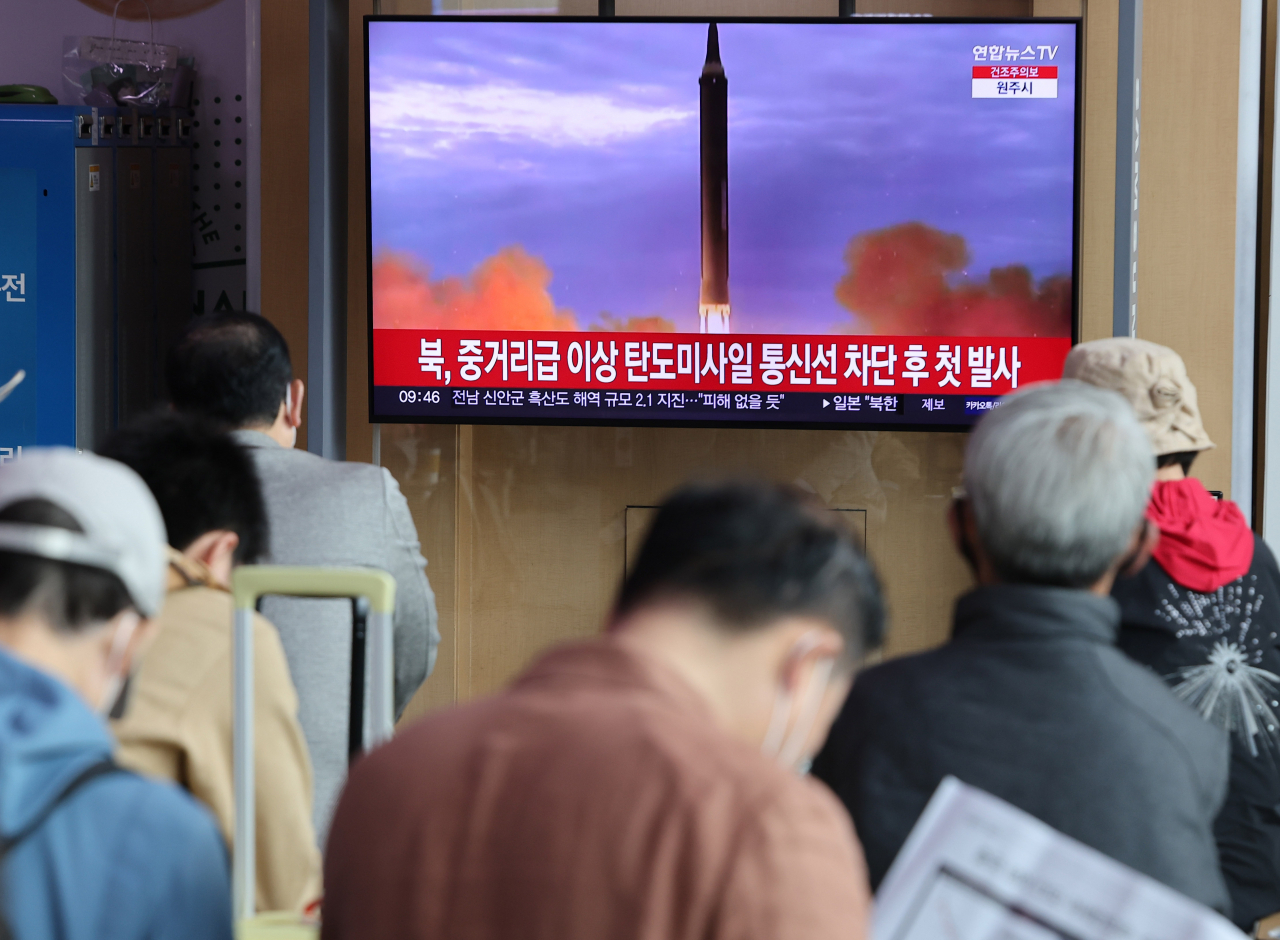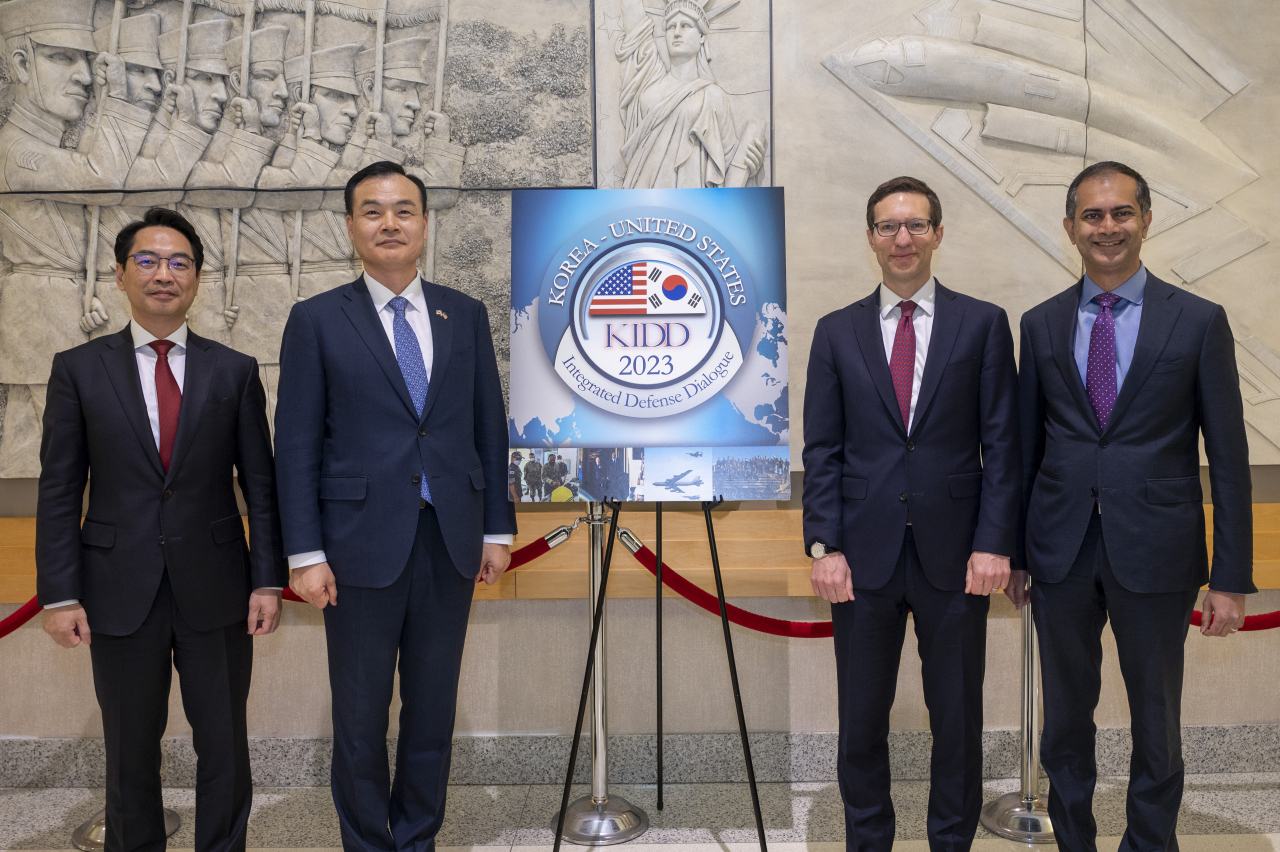North Korea fires suspected new solid-fuel ballistic missile
Missile launch comes hours before S. Korea, US announce outcomes of high-level defense talks
By Ji Da-gyumPublished : April 13, 2023 - 15:48

North Korea appears to have fired a new, solid-fuel, intermediate- or long-range ballistic missile Thursday, the South Korean military said hours after the launch. The initial assessment suggested that Pyongyang conducted its first test-launch of a solid-fuel intercontinental ballistic missile in the run-up to the anniversary of the birth of the country’s late founder.
North Korea fired the intermediate- or long-range ballistic missile into waters off its east coast from an area on the outskirts of the capital city of Pyongyang at 7:23 a.m., South Korea’s Joint Chiefs of Staff said.
The missile was fired at a lofted angle and traveled around 1,000 kilometers, the JCS said in a statement without further details, adding that South Korean and US intelligence authorities have been analyzing the missile’s specifications.
The missile flew at an altitude of below 3,000 km and traveled for more than 30 minutes, The Korea Herald learned.
North Korea has been assessed by South Korea to have “test-fired” a new-type solid-propellant ballistic missile based on flight trajectory and the color and pattern of the flame that provides thrust at liftoff, a South Korean senior official said on condition of anonymity during a closed-door briefing. The missile was also seen making at least one stage separation.
Solid-fuel missiles have advantages over liquid-fueled missiles in that they can be fueled during their manufacturing process. They can also be launched on short notice, and therefore have greater mobility and survivability.
The South Korean military had braced for the possibility that North Korea might test-fire a new solid-fuel intercontinental ballistic missile, or ICBM.
North Korea displayed an apparent new solid-fuel ICBM at a military parade in February.
The military also noted that North Korea tested what appears to have been a new model of a new solid-fuel rocket engine at the Sohae Satellite Launching Station in December 2022. The test of what North Korea labeled as the first-ever static firing testing of a “high-thrust solid-fuel motor with a thrust of 140 ton-force” was aimed at developing a new solid-fuel ICBM. Then, North Korean leader Kim Jong-un said he expected to see “another new-type strategic weapon within the shortest period of time” while guiding the testing.
Shin Jong-woo, a senior analyst at the Korea Defense and Security Forum, said North Korea's latest missile launch could be its first test-firing of a new solid-propellant ICBM.
“The missile flew at an altitude of below 3,000 km. But if we look into North Korea’s pattern of missile developments, the country does not usually fire a missile at a high altitude during its initial test,” Shin told The Korea Herald. “Therefore, if North Korea test-fired its new solid-fueled ICBM displayed at the recent military parade, there is a high chance that it will conduct another test-firing in the foreseeable future.”
Shin explained that the South Korean military would reach a conclusion in view of its different trajectory compared to liquid fuel ballistic missiles. A solid-fuel missile flies at faster speeds during its boost phase, for instance.
But the South Korean military also did not rule out the possibility that the latest missile launch was part of the North's preparations to launch its first military reconnaissance satellite. Last December, North Korea publicly pledged to complete its preparation to launch a spy satellite by this April.
The latest missile launch would “aim to test a new ballistic missile system, demonstrate its defense capabilities and nuclear power in the run-up to the birthday of Kim Il-sung on Saturday and reinforce internal solidarity,” the military official said when asked by The Korea Herald during a closed-door briefing.
North Korea gears up to celebrate the 111th anniversary of the late founder Kim Il-sung’s birth, dubbed as the Day of the Sun, which falls on April 15.
The missile launch was also seen as “backlash against the move by South Korea and the US to strengthen US extended deterrence,” the official said.

The latest missile launch notably came hours before South Korea and the United States announced the outcomes of their high-level defense talks held on Tuesday and Wednesday in Washington.
“The leaders committed to responding to DPRK provocations that undermine regional peace and stability through close and coordinated bilateral responses that demonstrate the strength of the alliance,” the joint press statement said, referring to North Korea by the acronym of its official name, the Democratic People’s Republic of Korea.
South Korea’s Defense Ministry and the US Defense Department discussed a wide range of issues, including ways to enhance the alliance’s deterrence and readiness against escalating North Korean threats and improve the viability of US extended deterrence at the 22nd Korea-US Integrated Defense Dialogue, or KIDD.
Deputy Minister for National Defense Policy Heo Tae-keun led the South Korean delegation while Assistant Secretary of Defense for Indo-Pacific Security Affairs Ely Ratner and Deputy Assistant Secretary of Defense for East Asia Siddharth Mohandas represented the US side.
Both sides also “concurred on the need to conduct practical combined exercises and training during the latter half of the year,” emphasizing the importance of returning to large-scale field exercises.
In particular, Seoul and Washington recognized the importance of staging combined readiness training to defend South Korean people and forces, as well as US forces deployed in South Korea, in light of North Korea’s recent “missile provocations.”
“Furthermore, the two sides emphasized that any nuclear attack by North Korea against the United States or its allies and partners is unacceptable and will result in the end of the Kim regime,” the statement read.
North Korea’s missile launch came as the country has refused to take regularly-held inter-Korean, military-to-military calls from South Korea for a week without explanation since April 7. The unilateral severance of inter-Korean hotlines is a violation of the mutual commitment to conduct calls twice a day, in the morning and afternoon, via liaison and military hotlines.
South Korea Unification Minister Kwon Young-se on Tuesday issued a rare public statement, the first of its kind since 2013, and urged North Korean leader Kim Jong-un to stop heightening tensions and make a “wise decision.” But North Korea resumed its missile launch after conducting seven sets of missile launches in March in an apparent protest to defense-oriented, regular military exercises between South Korea and the US.




















![[Today’s K-pop] BTS pop-up event to come to Seoul](http://res.heraldm.com/phpwas/restmb_idxmake.php?idx=642&simg=/content/image/2024/04/17/20240417050734_0.jpg&u=)